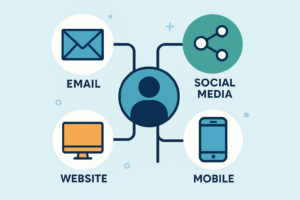Introduction
In today’s digital landscape, creating content that resonates isn’t enough—you need content that spreads. Viral marketing represents the holy grail of digital strategy: exponential reach achieved through organic sharing rather than paid promotion. But what separates content that fizzles from campaigns that ignite social media firestorms?
The answer lies in psychology. Understanding the cognitive triggers, emotional responses, and social dynamics that compel people to share content is the foundation of effective viral marketing. This comprehensive guide explores the psychological principles behind viral campaigns and provides actionable strategies for business owners and startups looking to create unforgettable marketing moments.
Understanding Viral Marketing: More Than Just Luck
Viral marketing isn’t about chance—it’s about engineering content that aligns with fundamental human psychological needs and social behaviors. When Dropbox offered extra storage for referrals, they weren’t just incentivizing sharing; they were tapping into reciprocity, social proof, and practical value. When Dollar Shave Club’s irreverent launch video accumulated millions of views, they leveraged humor, surprise, and relatability.
According to research by Jonah Berger, author of “Contagious: Why Things Catch On,” only 7% of word-of-mouth happens online, yet that 7% creates disproportionate impact because of its persistence and searchability. Understanding what makes content shareable requires examining both the emotional and practical factors that drive human behavior.
The Six STEPPS Framework: A Foundation for Virality
Jonah Berger’s research at the Wharton School identified six key principles that make content contagious, summarized by the acronym STEPPS:
1. Social Currency
People share content that makes them look good, knowledgeable, or connected. When someone shares your content, they’re using it as a form of self-expression and identity signaling. This is why exclusive information, insider knowledge, or content that showcases expertise tends to spread rapidly.
Practical Application: Create content that makes your audience feel like insiders. This could include:
- Early access to product launches or features
- Behind-the-scenes content that reveals your business processes
- Data-driven insights that aren’t widely available
- Expert-level tips that demonstrate your audience’s sophistication
Example: Spotify’s annual “Wrapped” campaign gives users personalized listening statistics that double as social currency—sharing these stats signals musical taste and creates FOMO (fear of missing out) among those who haven’t participated.
2. Triggers
Top of mind means tip of tongue. Content that’s linked to frequent environmental cues gets more sustained sharing than content that generates momentary excitement. This principle explains why Kit Kat’s association with coffee breaks proved more valuable than a Super Bowl ad spike.
Practical Application: Associate your brand or message with:
- Daily activities or routines
- Seasonal events or holidays
- Common phrases or cultural touchstones
- Regular pain points your audience experiences
The key is creating memorable associations that resurface whenever customers encounter relevant triggers in their environment.
3. Emotion
Content that evokes high-arousal emotions—whether positive (awe, excitement, amusement) or negative (anger, anxiety)—gets shared more than content that evokes low-arousal emotions like sadness or contentment. Research published in the Journal of Marketing Research confirms that emotional intensity predicts virality better than emotional valence (positive vs. negative).
Practical Application:
- Create content that inspires awe through unexpected facts or achievements
- Use humor that creates genuine laughter, not just smiles
- Address injustices or frustrations that spark righteous anger
- Build anticipation and excitement around launches or announcements
Avoid: Content that makes people feel sad or content, as these emotions lead to passivity rather than sharing.
4. Public
People imitate what they see others doing. When behavior is observable, it’s more likely to spread. This is why Apple’s white earbuds became iconic—they made iPod ownership visible—and why fundraising thermometers work by making progress public.
Practical Application:
- Design products or campaigns with built-in visibility (branded packaging, distinctive design)
- Create shareable badges, filters, or graphics people can display
- Make participation observable through hashtags or user-generated content campaigns
- Display social proof prominently (testimonials, user counts, success stories)
5. Practical Value
People share useful information. Content that helps others save time, money, or effort gets passed along because sharing practical value strengthens social bonds and positions the sharer as helpful.
Practical Application:
- Create how-to guides and tutorials that solve specific problems
- Develop tools, templates, or calculators your audience can use
- Share industry insights that help your audience make better decisions
- Offer exclusive deals or discounts that are worth sharing
The more immediately useful your content, the more likely it is to be shared with the specific people who need it most.
6. Stories
Information travels under the guise of idle chatter. Stories provide a narrative structure that makes information memorable and shareable. People don’t just share facts—they share the stories that contain those facts.
Practical Application:
- Frame your message within compelling narratives
- Use customer success stories to illustrate your value proposition
- Create origin stories that humanize your brand
- Develop serialized content that keeps people coming back
The most viral stories feature clear protagonists, conflicts, and resolutions—all while keeping your brand message integral to the narrative, not just tacked on.
The Neuroscience of Sharing: What Happens in the Brain
Understanding why people share requires looking beneath conscious motivation to the neurological mechanisms at play. Research using fMRI scans reveals that sharing activates the brain’s reward centers—specifically areas associated with self-referential thought and social cognition.
A study published in Proceedings of the National Academy of Sciences found that when people encounter content they want to share, regions associated with mentalizing (thinking about others’ thoughts and perspectives) show increased activity. This suggests that sharing is fundamentally a social process—we share content while simultaneously considering how it will be received by our network.
The Dopamine Effect
Sharing triggers dopamine release, the neurotransmitter associated with pleasure and reward. This biochemical response creates a reinforcement loop: sharing feels good, so we seek opportunities to share again. Smart marketers design content that maximizes this dopamine hit by:
- Validating identity: Content that affirms someone’s beliefs or identity triggers stronger reward responses
- Providing closure: Complete, satisfying narratives are more rewarding to share than incomplete information
- Creating surprise: Unexpected elements generate larger dopamine spikes than predictable content
The Psychology of Emotional Contagion
Emotional contagion—the phenomenon where emotions spread from person to person—is fundamental to viral marketing. Research by Facebook’s Data Science team demonstrated that emotional states can transfer through social networks, even through text-based content.
The Arousal Dimension
Not all emotions are created equal when it comes to virality. Katherine Milkman and Jonah Berger’s research identified that high-arousal emotions drive sharing, regardless of valence:
High-Arousal Positive Emotions:
- Awe (wonder, amazement)
- Excitement (anticipation, thrill)
- Amusement (humor, delight)
High-Arousal Negative Emotions:
- Anger (outrage, frustration)
- Anxiety (worry, fear about prevention)
Low-Arousal Emotions (Less Viral):
- Sadness (melancholy, disappointment)
- Contentment (satisfaction, peace)
Creating Awe-Inspiring Content
Awe is perhaps the most powerful emotion for viral marketing. It occurs when we encounter something vast that transcends our existing understanding. Content that inspires awe:
- Showcases unexpected scale or scope
- Reveals hidden patterns or connections
- Demonstrates exceptional skill or achievement
- Presents nature or human accomplishment in new ways
Campaigns like Dove’s “Real Beauty Sketches” or Always’ “Like a Girl” achieved viral status partly by reframing familiar concepts in ways that created awe and challenged assumptions.
Social Identity Theory and Tribal Marketing
People don’t just share content—they share identities. Social Identity Theory, developed by Henri Tajfel, explains that people derive part of their self-concept from group memberships. Viral marketing often succeeds by creating or reinforcing tribal affiliations.
Building In-Groups Through Marketing
Successful viral campaigns often:
- Define clear in-groups and out-groups: Apple’s “Mac vs. PC” campaign created distinct tribes
- Use exclusive language or symbols: Crypto communities, gaming culture, and brand fandoms all develop their own vocabularies
- Create participation rituals: Challenges, hashtags, or traditions that signal membership
- Celebrate in-group values: Content that reinforces what the tribe believes or cares about
Case Study: REI’s #OptOutside Campaign
REI’s decision to close stores on Black Friday and encourage customers to spend time outdoors instead resonated because it reinforced the identity and values of their core audience. The campaign wasn’t just marketing—it was a tribal rallying cry that generated massive earned media and social sharing because it made participants feel part of something meaningful.
The Scarcity and Urgency Principles
Psychological research consistently shows that scarcity increases perceived value. Robert Cialdini’s work on influence principles demonstrates that opportunities seem more valuable when their availability is limited. This explains the effectiveness of:
- Limited-time offers: Creating urgency through deadlines
- Exclusive access: Providing early or restricted access to select groups
- Limited quantities: Emphasizing finite availability
- Countdown mechanics: Making scarcity visible through timers or inventory displays
FOMO: The Modern Marketing Catalyst
Fear of Missing Out (FOMO) has become a dominant psychological driver in the social media age. A study published in Computers in Human Behavior found that FOMO correlates strongly with social media engagement and sharing behavior. Viral campaigns leverage FOMO by:
- Creating events or experiences that are time-sensitive
- Using social proof to show others participating
- Emphasizing the unique nature of the opportunity
- Making participation visible to others
Supreme’s product drops exemplify FOMO marketing—limited quantities, unpredictable release dates, and resale markets that reinforce scarcity all contribute to sustained viral interest.
The Power of Narrative Transportation
When people become absorbed in a story, they experience “narrative transportation”—a mental state where they’re fully immersed in the narrative world. Research by Melanie Green and Timothy Brock shows that transported readers are more persuaded by story-embedded messages and less likely to counter-argue.
Crafting Transportive Brand Stories
Effective viral narratives:
- Feature relatable protagonists: Characters your audience can identify with
- Include sensory details: Vivid descriptions that enhance immersion
- Build tension and resolution: Story arcs that create emotional investment
- Integrate messages organically: Themes that emerge naturally from the story
Always’ “Like a Girl” campaign succeeded partly through narrative transportation—viewers didn’t feel marketed to; they felt engaged in a meaningful exploration of how language shapes confidence.
The Pratfall Effect and Authentic Vulnerability
Research by psychologist Elliot Aronson discovered the “pratfall effect”—people who make mistakes are often perceived as more likeable than those who appear perfect, provided they’re already seen as competent. This has significant implications for viral marketing.
Humanizing Your Brand
Campaigns that show vulnerability or acknowledge imperfection often resonate more deeply than polished corporate messaging:
- Admitting mistakes: Taking responsibility builds trust
- Behind-the-scenes authenticity: Showing the messy reality behind the finished product
- User-generated content: Embracing real customer experiences, imperfections and all
- Founder stories: Sharing struggles and failures alongside successes
Domino’s Pizza’s “Pizza Turnaround” campaign exemplifies this approach—the company acknowledged their pizza wasn’t good, showed genuine efforts to improve, and created an authentic narrative that resonated with audiences tired of corporate perfection.
Social Proof and the Bandwagon Effect
The principle of social proof—people look to others to determine correct behavior—is perhaps the most fundamental driver of viral spread. As content accumulates shares, likes, and comments, it becomes increasingly likely to attract more engagement.
Types of Social Proof in Viral Marketing
- Wisdom of crowds: High engagement numbers signal value
- Expert endorsements: Influencers and thought leaders lending credibility
- Peer similarity: People like you are engaging with this content
- Celebrity association: Famous people participating or endorsing
The Network Effect in Action
Each share doesn’t just reach new people—it signals to existing observers that the content is worth their attention. This creates exponential growth curves where initial shares seed broader awareness, which generates more shares, creating a self-reinforcing cycle.
Understanding Metcalfe’s Law (the value of a network grows with the square of the number of users) helps explain why viral content accelerates—each new participant doesn’t just add one more person but increases the overall network value for everyone.
The Peak-End Rule and Memorable Experiences
Nobel laureate Daniel Kahneman’s research on the peak-end rule reveals that people judge experiences largely based on their most intense moment (the peak) and how they end. This has direct applications to viral marketing campaigns.
Designing for Memorable Peaks
Create content or experiences with:
- Standout moments: Surprising twists, emotional crescendos, or unexpected revelations
- Strong endings: Satisfying conclusions or compelling calls-to-action that leave lasting impressions
- Sensory intensity: Heightened emotional or cognitive engagement at key points
Red Bull’s Stratos jump—Felix Baumgartner’s record-breaking freefall from the edge of space—created an unforgettable peak moment that defined the campaign and generated massive viral sharing.
The Curiosity Gap and Information Gaps
George Loewenstein’s Information Gap Theory explains that curiosity arises when we perceive a gap between what we know and what we want to know. This creates cognitive tension that we’re motivated to resolve.
Ethical Clickbait: Opening Loops Responsibly
While “clickbait” has negative connotations, the underlying psychological principle is sound:
- Pose intriguing questions: Without providing immediate answers
- Tease valuable information: That requires engagement to access
- Create anticipation: Through serialized content or scheduled reveals
- Use pattern interrupts: Unexpected information that demands explanation
The key is ensuring that your content delivers on the curiosity it creates. Disappointed audiences don’t just ignore future content—they actively warn others away.
The Zeigarnik Effect
Related to curiosity gaps, the Zeigarnik Effect describes our tendency to remember incomplete tasks better than completed ones. Viral campaigns leverage this by:
- Creating multi-part series or campaigns
- Using cliffhangers in serialized content
- Launching teaser campaigns before major announcements
- Building ongoing narratives that reward sustained attention
Reciprocity and Value-First Marketing
The principle of reciprocity—people feel obligated to return favors—is fundamental to human social interaction. When you provide genuine value upfront, recipients often feel compelled to reciprocate through sharing, engagement, or eventual purchase.
Implementing Reciprocity in Campaigns
- Free tools and resources: Useful products that require no purchase
- Extensive educational content: Courses, guides, or tutorials that solve real problems
- Generous free trials: Extended access that demonstrates value
- Unexpected bonuses: Surprise additional value that exceeds expectations
Canva’s freemium model exemplifies reciprocity-based viral growth—by providing genuinely useful free design tools, they created millions of advocates who both use and recommend the product.
The Ikea Effect and User Participation
Research by Michael Norton, Daniel Mochon, and Dan Ariely revealed the “Ikea Effect”—people value things more highly when they’ve invested effort in creating them. Viral campaigns that involve user participation tap into this psychological phenomenon.
Creating Participatory Campaigns
- User-generated content challenges: TikTok challenges, hashtag campaigns, or photo contests
- Customization and personalization: Allowing users to create their own versions
- Co-creation opportunities: Inviting audiences to contribute to product development or content creation
- Interactive experiences: Quizzes, polls, or tools that require active engagement
The ALS Ice Bucket Challenge became a viral phenomenon partly because it required active participation—people weren’t just sharing content but creating it, which increased both investment and sharing motivation.
Timing and Cultural Relevance
Even psychologically optimized content can fail if timing is wrong. Successful viral campaigns often demonstrate:
Newsjacking and Trend Surfing
- Cultural moment awareness: Understanding current conversations and concerns
- Rapid response capability: Being able to create and deploy relevant content quickly
- Authentic connection: Ensuring your participation in trends feels genuine, not forced
Oreo’s “You can still dunk in the dark” tweet during the 2013 Super Bowl blackout exemplifies perfect timing—a simple, relevant message posted at exactly the right moment generated massive viral spread.
Seasonal and Cyclical Opportunities
Understanding predictable cycles allows strategic planning:
- Annual events (holidays, awareness months, sporting events)
- Industry-specific cycles (tax season for financial services, back-to-school for education)
- Cultural traditions and celebrations
- Economic cycles and consumer behavior patterns
Platform-Specific Psychology
Different social platforms activate different psychological mechanisms and serve different social needs. Understanding platform psychology is crucial for viral success.
Instagram: Identity and Aspiration
Instagram’s visual nature makes it ideal for:
- Identity signaling through aesthetic choices
- Aspiration and inspiration
- Behind-the-scenes authenticity
- Lifestyle marketing and influencer partnerships
Twitter/X: Real-Time Reaction and Public Discourse
Twitter’s format encourages:
- Witty, concise commentary
- Rapid news response and newsjacking
- Public debate and conversation
- Thought leadership and expert positioning
TikTok: Entertainment and Participation
TikTok’s algorithm and format favor:
- Entertainment value over follower count
- Trend participation and creative variation
- Authentic, unpolished content
- Music and audio-driven virality
LinkedIn: Professional Identity and Thought Leadership
LinkedIn’s professional context makes it ideal for:
- Industry insights and expertise sharing
- Career success stories
- Business lessons and frameworks
- Professional networking and relationship building
Measuring and Optimizing Viral Potential
Understanding psychology is just the beginning—successful viral marketing requires systematic measurement and optimization.
Key Metrics Beyond Vanity Numbers
- Amplification rate: Shares per post relative to followers
- Emotional resonance: Sentiment analysis and comment quality
- Network spread: How far content travels beyond initial audience
- Conversion path: How viral traffic converts to desired actions
- Earned media value: Equivalent advertising cost of organic reach
A/B Testing Psychological Elements
Test variations of:
- Emotional appeals (awe vs. humor vs. anger)
- Social proof elements (testimonials, user counts, expert endorsements)
- Scarcity and urgency messaging
- Narrative framing and story structures
- Visual elements and attention-grabbing techniques
Ethical Considerations in Viral Marketing
With great psychological power comes great responsibility. Ethical viral marketing requires:
Transparency and Honesty
- Avoiding manipulation through false scarcity or fake urgency
- Being honest about product capabilities and limitations
- Disclosing paid partnerships and sponsored content
- Respecting privacy and data protection
Avoiding Harmful Virality
- Not exploiting fear or anxiety beyond reasonable concern
- Avoiding divisive content that damages social fabric
- Considering unintended consequences of campaigns
- Taking responsibility for how content is used and shared
Building Long-Term Trust
While manipulation might generate short-term virality, sustainable success requires:
- Consistently delivering on promises
- Building authentic relationships with audiences
- Creating value beyond viral moments
- Maintaining brand integrity across campaigns
Building a Viral Marketing Strategy
Implementing psychological principles requires systematic approach:
Phase 1: Foundation Building
- Understand your audience deeply: Demographics, psychographics, pain points, and aspirations
- Identify your brand’s psychological positioning: What emotions, values, and identity does your brand represent?
- Audit your current content: Which pieces generated the most engagement and why?
- Study successful viral campaigns: Both within and outside your industry
Phase 2: Content Creation
- Apply STEPPS principles: Ensure content incorporates social currency, triggers, emotion, public visibility, practical value, or stories
- Design for specific platforms: Optimize format, tone, and structure for where you’ll publish
- Create participation opportunities: How can audiences engage beyond passive consumption?
- Build in shareability: Make sharing easy, visible, and rewarding
Phase 3: Strategic Launch
- Seed strategically: Identify influential early adopters in your network
- Optimize timing: Launch when your audience is most receptive
- Monitor and respond: Engage with early participants to build momentum
- Amplify selectively: Use paid promotion strategically to reach critical mass
Phase 4: Sustain and Scale
- Ride the wave: Continue engaging while content spreads
- Capture attention: Convert viral traffic with clear calls-to-action
- Document learnings: Analyze what worked and why
- Build on success: Create follow-up campaigns that maintain momentum
Common Pitfalls to Avoid
Even with strong psychological foundations, campaigns can fail due to:
Over-Engineering
- Forced virality: Content that tries too hard feels inauthentic
- Feature overload: Complexity that obscures the core message
- Obvious manipulation: Transparent psychological tricks that feel exploitative
Misaligned Messaging
- Brand disconnect: Viral content that doesn’t connect to your actual business
- Audience mismatch: Content that attracts the wrong people
- Value confusion: Viral moments that don’t translate to business value
Poor Execution
- Technical failures: Broken links, crashed websites, or poor mobile experience
- Insufficient preparation: Infrastructure that can’t handle viral traffic
- Slow response: Inability to capitalize on unexpected virality
Case Studies: Psychology in Action
Dove’s Real Beauty Campaign
Psychological Principles:
- Challenged beauty standards (anger at injustice)
- Created awe through perspective shift
- Built social currency for sharers
- Told authentic, emotional stories
- Aligned with audience values and identity
Results: The campaign generated over 114 million views and fundamentally repositioned Dove’s brand around authentic beauty.
ALS Ice Bucket Challenge
Psychological Principles:
- High participation requirements (Ikea Effect)
- Public visibility of participation
- Social proof and bandwagon effect
- Challenge/dare psychology
- Practical value (fundraising for important cause)
- FOMO from widespread participation
Results: The campaign raised over $220 million for ALS research and achieved unprecedented awareness through 17 million video uploads.
Old Spice’s “The Man Your Man Could Smell Like”
Psychological Principles:
- Humor creating high-arousal positive emotion
- Absurdist surprise elements
- Gender-based social identity
- Memorable character and catchphrases (triggers)
- Interactive response videos (participation)
Results: The campaign generated 1.4 billion impressions, 105% sales increase, and became a cultural phenomenon.
The Future of Viral Marketing Psychology
As platforms evolve and audiences become more sophisticated, viral marketing psychology continues to develop:
Emerging Trends
- Authenticity over polish: Raw, genuine content increasingly outperforms produced material
- Community-driven virality: Niche communities amplifying content to broader audiences
- Cross-platform orchestration: Viral campaigns spanning multiple platforms with platform-specific content
- AI-personalized virality: Content that goes viral within micro-segments through algorithmic customization
- Virtual and augmented reality: Immersive experiences creating new forms of shareable content
Adapting to Platform Changes
Social media platforms continuously adjust algorithms and features, requiring:
- Continuous learning and adaptation
- Focus on fundamental psychological principles over platform-specific tactics
- Diversification across multiple channels
- Direct audience relationships (email, community) that transcend platform changes
Conclusion: From Theory to Practice
Understanding the psychology of viral marketing transforms content creation from random luck to strategic science. While no campaign is guaranteed to go viral, applying these psychological principles dramatically increases your odds:
- Ground every campaign in clear psychological principles: Know which cognitive biases, emotional triggers, or social dynamics you’re activating
- Prioritize authenticity and value: Manipulation might generate short-term attention, but genuine value builds sustainable success
- Design for sharing from the start: Don’t treat virality as an afterthought—build shareability into your content structure
- Test, measure, and iterate: Use data to understand what resonates with your specific audience
- Stay ethically grounded: Build trust and long-term relationships rather than exploiting psychological vulnerabilities
Viral marketing isn’t about creating content that tricks people into sharing—it’s about understanding what people genuinely want to share and why. By aligning your campaigns with fundamental human psychology, you create marketing that doesn’t just spread but resonates, connects, and ultimately drives business growth.
The businesses that master viral marketing psychology don’t chase trends—they understand the timeless psychological principles that drive human behavior and apply them strategically to create unforgettable campaigns. Start by deeply understanding your audience, apply these psychological frameworks systematically, and continually learn from both successes and failures. The viral moments you create can transform your business trajectory, but only if grounded in genuine value and authentic human connection.
References and Further Reading
- Berger, J. (2013). Contagious: Why Things Catch On. Simon & Schuster.
- Heath, C., & Heath, D. (2007). Made to Stick: Why Some Ideas Survive and Others Die. Random House.
- Cialdini, R. B. (2006). Influence: The Psychology of Persuasion. Harper Business.
- Kahneman, D. (2011). Thinking, Fast and Slow. Farrar, Straus and Giroux.
- Milkman, K. L., & Berger, J. (2012). “What Makes Online Content Viral?” Journal of Marketing Research, 49(2), 192-205.
- Loewenstein, G. (1994). “The Psychology of Curiosity: A Review and Reinterpretation.” Psychological Bulletin, 116(1), 75-98.
- Norton, M. I., Mochon, D., & Ariely, D. (2012). “The IKEA Effect: When Labor Leads to Love.” Journal of Consumer Psychology, 22(3), 453-460.
- Green, M. C., & Brock, T. C. (2000). “The Role of Transportation in the Persuasiveness of Public Narratives.” Journal of Personality and Social Psychology, 79(5), 701-721.
Recommended Resources
- Wharton School’s Viral Marketing Research: https://marketing.wharton.upenn.edu/profile/berger/
- Content Marketing Institute: https://contentmarketinginstitute.com/
- Social Media Examiner: https://www.socialmediaexaminer.com/
- Nielsen Norman Group (UX and Psychology): https://www.nngroup.com/
- Psychology Today – Consumer Behavior: https://www.psychologytoday.com/us/basics/consumer-behavior
- HubSpot Marketing Blog: https://blog.hubspot.com/marketing
- BuzzSumo (Content Analysis): https://buzzsumo.com/
- Think with Google (Consumer Insights): https://www.thinkwithgoogle.com/




